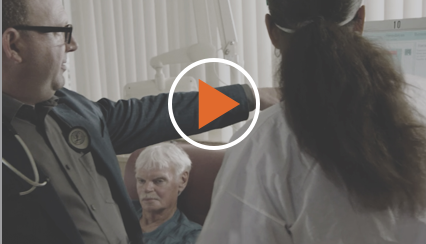
Anna Chambers
Annette Dillon
Jillian Golan
Colleen Guffee
Linda Roberto
Dr. David Henner
Dr. Abdul Abdellatif
Debbie Glidden
Dialysis Care Team
- Anna Chambers, RD
- Annette Dillon, RN
- Jillian Golan, RD
- Colleen Guffee, RD
- Linda Roberto, RD
Prescribers
- Dr. Abdul Abdellatif
- Debbie Glidden, NP
- Dr. David Henner
Managing lab values is one of my primary areas of focus. And so much of that is beyond our control. Parsabiv® made a difference because patients could now come into the facility for their treatment.
I just looked back at our data from 2018, when we first started using Parsabiv® at our clinic. At that time, there was a decrease in the number of patients with PTH greater than 600.
As dietitians, if we see the PTH trending up, that’s going to jump out at us. If we can control the phosphorus with diet first and phosphorus binders if needed, it’s easier to manage the PTH. But if we see a patient failing on an oral calcimimetic, or other vitamin D analogs, we might consider a switch to Parsabiv®.
Individual results may vary
Looking at Patients Holistically
I keep everyone informed. They need to understand that we have goals we’re all working toward together. That includes the patients. Our physicians have always been easy to work with and are open to the suggestions of the nursing staff. We are the ones on the front line, looking at labs, algorithms, and best practices. We discuss our ideas and share opinions in meetings and come to consensus together.
I work with them to understand why it’s important to be in a better state of health. If their goal is to live longer, they need to take steps to make it happen. I gain their trust, and I think that’s the biggest issue with the dialysis community. They need to trust your judgement and what you’re telling them. They are the reason I’m here.
I usually wait to draw up the medication until the last hour of the patient’s treatment. I keep it in the refrigerator. My technicians tell me when it’s rinse back, and that’s when I give it. We do use the “remember rinse back” tags as a reminder to our technicians to stay consistent.
Individual results may vary
*Please see Parsabiv® prescribing information for full dosing and administration instructions.
Managing Multiple Patients
Why Parsabiv®?
I would say it’s personal with me. I feel like I’m here for a reason. I am here for these patients. I’m here to help manage their diet and medications, so their labs can get down to within range. They need me to tell them what’s wrong and how they can fix it.
While I have support staff that help me, I don’t put that on anyone but myself. If a phosphorus, PTH, or calcium is off, I take full ownership of discussing it with the patient. I will reach out to the doctor, especially when I have a concern I want to run by him. At our Quality Improvement meetings, I’m the one reporting the numbers, and I don’t want to report bad numbers. So I take ownership and do whatever I can to inspire patients and empower them to get the numbers where they need to be.
I'll evaluate a patient's lab values, and if they don't seem to be meeting our goals, I'll present the patient's levels to the doctor. We've had good success with Parsabiv® reducing patient's lab values, and appreciate that it offers control over administration. Doctors have been willing to work with me based on a patient's needs.
Individual results may vary
Looking at Patients Holistically
Managing Multiple Patients
It’s funny how it works sometimes. Patients might be more willing to open up to their care technician rather than me or a nurse because they work with them a lot more. At our staff meetings I ask everyone to keep me in the loop in case I’m missing something. A patient may tell me they’re doing fine and tell someone else they’ve been sick for the past week. It’s as if the patients tell the dietitians their social problems and tell the social workers their dietary problems.
When talking about sHPT, it’s not just about calcium, phosphorus, and PTH. It’s such a big undertaking for them. The diet is hard, and the medication load can be challenging. Patients want to know that it’s all worth it. Setting goals keeps them focused.
In checking our records, we've generally seen an improvement in PTH levels in many of the patients we've treated with Parsabiv®. In our market, you’ll find that most clinics have incorporated Parsabiv® into their practice.
Individual results may vary
Managing Multiple Patients
Why Parsabiv®?
Absolutely. When I train other dietitians, I say that labs are how they grade us. Our superiors don’t see our patient interactions, but they see our numbers. We must own the labs and do whatever we can to improve lives. Once a month, the whole company basically looks at the numbers. I’m very competitive, so I like to win.
I never look at just one set of labs. I look at the trends, and, of course, the diet. I look at the patients’ body weight. I find out if they’re skipping treatments or shortening their treatment time. If so, their health is not going to be what it should be. And then there’s their home life. I look at the whole picture. Between the nurses, techs, social worker, and me, we work great as a team.
Not having to remember to take another pill is an important option to have for these patients. I initiated them on Parsabiv® and it helped.
Individual results may vary
Looking at Patients Holistically
Why Parsabiv®?
In the past, when I would think about treating secondary hyperparathyroidism, it was a lot like juggling. Treatment for me could include prescribing my patients phosphate binders and vitamin D. Sometimes, the phosphate binders would cause my patient’s calcium levels to go up. And if you give vitamin D, that could raise the calcium and phosphorus; so in those instances it would feel like you’re kind of chasing your tail.
Parsabiv® has had a huge impact on what we do at our practice in regards to the way we treat sHPT. For myself, and most of my colleagues, we routinely write Parsabiv® for appropriate patients. And I see that trend continuing because we have seen good results when managing sHPT with Parsabiv®.
I would say, if you have a patient who you believe could benefit from a treatment like Parsabiv® (etelcalcetide), you have to advocate for them. And I do that every day. Ultimately, we’ve got to do what we feel is right for our patients. I couldn’t sleep at night unless I felt today, I did all I can for my patients. That’s my responsibility—and I think most nephrologists feel the same way.
Individual results may vary
Early Experience
Parsabiv® in Practice
Care Team Dynamics
I was cautiously optimistic that Parsabiv® (etelcalcetide) would help because now we are in control of administering the medication to our patients. Parsabiv® further justified my belief in calcimimetics.
I have this one patient with sHPT—she had a wake-up call when I recommended she meet with a surgeon. Up until then, she wasn’t very active in her care. As soon as Parsabiv® (etelcalcetide) came out, she was the first patient in her dialysis unit to receive it. We initiated her on 5 milligrams, 3 times a week at the end of hemodialysis, and we titrated her dose based on her labs. We didn’t even need to titrate to the maximum dose and in a few months her PTH was in normal range. Her PTH is still in range without me having to significantly change her dose. Her secondary hyperparathyroidism is well managed and she is more active in her care.
It feels great to share good news with patients because frankly these are people who may not be used to hearing a lot of good news. That’s really inspiring to me, and now I am working very closely with my care team to monitor and identify other patients who may be appropriate for Parsabiv® (etelcalcetide).
Individual results may vary
Early Experience
Parsabiv® in Practice
Making a Difference
Care Team Dynamics
First and foremost, I will write Parsabiv® when I feel it’s important for us to control administration. We initiate Parsabiv® (etelcalcetide) for appropriate patients in order to manage their sHPT. We start them out at the approved dose, which is 5 mg 3 times a week, at the end of hemodialysis. It’s important to ensure that a patient’s serum calcium is at or above the lower limit of normal before initiating Parsabiv®. Following initiation, check the patient’s calcium levels after 1 week, then every 4 weeks after that. Also, you need to check the patient’s PTH levels after 4 weeks, then continue to check PTH based on whatever your practice does. Of course, all dosing and monitoring information can be found in the package insert.
Once you’ve decided to prescribe Parsabiv®, you need to work with your dialysis organization to make sure you get that patient on Parsabiv®.
I cannot stress enough the peace of mind I have knowing that I control administration with Parsabiv®. I’ve been in dialysis over 30 years and I’ve seen what these patients go through. It’s not an easy life. That’s why I fight for Parsabiv®—I do it for my patients because I care about them, and I’ve seen the difference Parsabiv® can make. And that’s what matters most to me. It works.
We work together to establish great communication, which relates to everyone knowing what our treatment goals are for sHPT—aligning on what labs we want to achieve and how to get there. Also knowing what triggers exist when it’s time to start a new therapy.
Individual results may vary
Parsabiv® in Practice
Making a Difference
Care Team Dynamics
Spotlight on Nephrology Podcast
Tune in to this series featuring nephrologists and other nephrology professionals to learn more about Parsabiv® (etelcalcetide) and how changing dynamics are affecting some patients with sHPT.
EFFICACY
See how Parsabiv® performed
in clinical trials and its use in real-world outcomes
REIMBURSEMENT
Parsabiv® reimbursement
options are available for
patients
REAL-WORLD EVIDENCE
See an analysis from
hundreds of real-world treatment experiences


